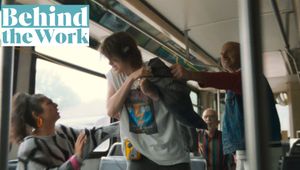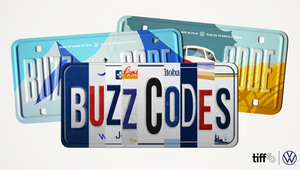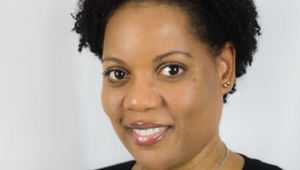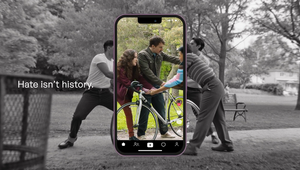
Why This Canadian Organisation is Challenging People to Look beyond the ‘Trans’ Label

While around the world, the exact specifics of what transgender people go through varies from continent to continent, country to country, and circumstance to circumstance, there’s one factor that’s consistent, no matter where you might be. Your identity - both the way you see yourself, and the way others perceive you - is probably going to experience a turbulent journey.
You see, for the majority of us, it’s hard to shake the ‘trans’ logo… ever, really. Sure, some who have the ability to access HRT eventually hit a point of passing where their past selves are but a shadow that the majority don’t remember, but even then, it’s not like you can just forget who you are, or where you came from. And, to be honest, other people don’t let you either. It’s both a blessing and a curse. Advocacy and being visible, especially in times like these, matters immensely. Seeing trans people in various public-facing positions sends a strong signal to questioning youth, inviting them to consider who they might actually be, and realise that it’s possible to make it all the way as their true selves.
But, equally so, it becomes hard for people, or even ourselves, to see past that label. While many are proud to be trans, it’s not a sole identifying trait. And worse, for some, it feels like a harsh reminder that the body they were born into wasn’t right, or, in best case scenarios, a compensatory method to get people to see them the way they’d actually like to be viewed. ‘Oh, people aren’t going to see my physical appearance as aligning with my gender, but if I qualify it with ‘trans’, maybe they’ll try to be understanding’. Truly, the definition is forced to put in so much work, serving as everything from an identifier, to a curse, to an explainer… when it shouldn’t have to be any of these at all.
To this end, Egale Canada and VML Canada wanted to make a campaign looking at just this. So, the two invited three accomplished Canadians, Lucas, a major label recording artist; Jessica, a former professional hockey player, and Jazmine, a model and performer to come share their stories. Looking at their accomplishments and all that it took to get them to the top of their fields, the work serves as a powerful reminder that the decision to distil people down to their gender-identity is absurd, when they’re so much more than that. After all, a person is far more than a label!
To learn more about how this came to life, LBB’s Jordan Won Neufeldt sat down with VML Canada executive creative director Allen Kwong and creative director Mike Richardson, as well as Egale Canada’s director or marketing, Jennifer Boyce, for a chat.
LBB> What was the brief for this campaign, and what immediate ideas came to mind?
Jennifer> Egale Canada has been working with VML Canada for almost four years now (since it was still known as TAXI), so we knew from experience that it would be the right partner for this campaign. There’s an ongoing increase in anti-2SLGBTQI hate and misinformation that is particularly targeting trans and gender diverse communities. For this campaign, we set out to encourage viewers to see the person, not the label by sharing the stories of three inspiring role models who just happen to be trans.
Our brief was informed by important information that we learned through our own public opinion polling which found that when someone did know a trans person, they were less likely to support harmful policies and legislation.
Allen> Our idea was to do something that felt entirely unlike an advocacy campaign. We took inspiration from the worlds of music and sports, which often do a great job getting audiences to connect with high-level athletes and entertainers – their struggles, their hopes and dreams, and ultimately their accomplishments.
Mike> Our idea was simply to challenge audiences to look beyond a label. To see trans people for everything that they are. And in the process, make the public aware of prejudice and remind everyone that human beings can’t be defined by just one word.
LBB> Tell us about the writing process for this campaign, across the spots and newspaper ads. How did you toe the line between sensitive yet poignant?
Mike> Writing the films started with a lot of research. We learned everything we could about Lucas, Jessica and Jazmine online first. But the most important step was sitting down with them, one on one, to hear their stories in their own words. We wanted the scripts to be powerful and poetic. Finding just the right words was a rewarding challenge that took a few rounds.
The films were purposefully shot to make the end reveal as powerful as possible. Our subjects told their relatable stories, and got viewers to connect, before asking a question directly to camera: ‘But to some people, I’m just trans, right?’.
As for the print ads, we didn’t design those until after the writing was done. Again, we worked closely with Jessica, Jazmine, and Lucas because we wanted to be authentic. We weren’t just writing copy – we were sharing their real stories. We met with each of them several times to ensure we were weaving their lived experiences and their personalities into something powerful.
Jennifer> Truly, Lucas, Jazmine, and Jessica are all remarkable – accomplished in their fields with incredible stories to share. We wanted the tone to be honest and emotive, but not heavy. We wanted people to feel a connection to their stories and feel inspired to share them with others. We are aiming to reach the 67% of Canadians who do not know a trans person, and show them how important it is to look beyond labels.

LBB> What was the filming process like? What went into making each spot, and do you have any anecdotes from on set?
Mike> It was our first time shooting in a studio with a volumetric wall, so that was exciting. It allowed us to create environments and virtual locations that felt immersive. We integrated archival video and photos that Lucas, Jazmine, and Jessica provided. The result felt like we were taking a journey through space and time right alongside them.
Our director, Sean McLeod, also shot most of the visual effects in-camera, like the shot of multiple hands brushing Jazmine’s hair (which was achieved using mirrors), the shimmering spotlight behind Jazmine’s silhouette (backlit carbonated water), and Lucas standing in front of a packed audience.
LBB> The editing also adds an extra layer to the final product. What was the post process like, and how did you ensure each spot would pop?
Mike> Sean was also our editor! He had a clear vision of what to capture on set and how it would all come together in the edit. Almost all the effects in the films were captured practically on set, so there was less reliance on post-production than you might expect. What you see on the screen is largely what we shot – thanks to Sean and our fantastic production company Off Screen Romance.

LBB> Since launch, how have people responded to this campaign?
Mike> So far, the reception has been very positive! We’ve seen a lot of messages of support for the print and films, and a lot of social comments. But we know that you can’t change everyone’s mind right away. This is a positive step in the right direction.
Jennifer> From our target audiences, the response has been very positive. Unfortunately, there are some coordinated groups continuing to spread anti-2SLGBTQI and anti-trans hate. That’s why this campaign and the message behind it is so important.
LBB> For those who might want to support the work you’re doing, is there anything else you’d like to share about Egale?
Jennifer> Allies and our 2SLGBTQI communities are continuing to work together to create a more inclusive world where everyone can thrive. We encourage everyone to join us by watching and sharing Lucas, Jessica, and Jazmine’s stories, which you can find at egale.ca/seetheperson.
Those who are comfortable can also share their own story using the hashtag ‘#SeeThePerson’. Coming together to take a stand against hate and showing up for 2SLGBTQI rights is more important than ever. If you would like to make a contribution that will allow us to continue this critical work, please visit egale.ca/donate.

LBB> Finally, what did the chance to be involved in this campaign mean to you, and is there any advice you’d give to Canadians who might want to change how they see the trans community?
Allen> I’m a member of the 2SLGBTQI community, and two people on the creative team have close family members that are trans. This is a message that we really care about, and a campaign that everyone on the team was proud to be a part of.
Jennifer> Too often, trans people are defined only by their ‘transness’, and not by the countless other things that make up who they are. If more people took the time to look closer, they’d see human beings with hopes and dreams and unique stories to tell. We’re encouraging everyone to watch Lucas, Jessica, and Jazmine’s stories, and to join us in taking a stand against anti-trans hate.















